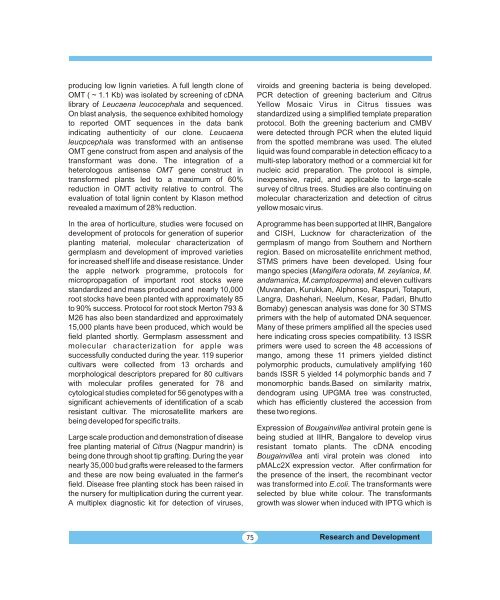ANNUAL REPORT - Department of Biotechnology
ANNUAL REPORT - Department of Biotechnology
ANNUAL REPORT - Department of Biotechnology
Create successful ePaper yourself
Turn your PDF publications into a flip-book with our unique Google optimized e-Paper software.
producing low lignin varieties. A full length clone <strong>of</strong><br />
OMT ( ~ 1.1 Kb) was isolated by screening <strong>of</strong> cDNA<br />
library <strong>of</strong> Leucaena leucocephala and sequenced.<br />
On blast analysis, the sequence exhibited homology<br />
to reported OMT sequences in the data bank<br />
indicating authenticity <strong>of</strong> our clone. Leucaena<br />
leucpcephala was transformed with an antisense<br />
OMT gene construct from aspen and analysis <strong>of</strong> the<br />
transformant was done. The integration <strong>of</strong> a<br />
heterologous antisense OMT gene construct in<br />
transformed plants led to a maximum <strong>of</strong> 60%<br />
reduction in OMT activity relative to control. The<br />
evaluation <strong>of</strong> total lignin content by Klason method<br />
revealed a maximum <strong>of</strong> 28% reduction.<br />
In the area <strong>of</strong> horticulture, studies were focused on<br />
development <strong>of</strong> protocols for generation <strong>of</strong> superior<br />
planting material, molecular characterization <strong>of</strong><br />
germplasm and development <strong>of</strong> improved varieties<br />
for increased shelf life and disease resistance. Under<br />
the apple network programme, protocols for<br />
micropropagation <strong>of</strong> important root stocks were<br />
standardized and mass produced and nearly 10,000<br />
root stocks have been planted with approximately 85<br />
to 90% success. Protocol for root stock Merton 793 &<br />
M26 has also been standardized and approximately<br />
15,000 plants have been produced, which would be<br />
field planted shortly. Germplasm assessment and<br />
molecular characterization for apple was<br />
successfully conducted during the year. 119 superior<br />
cultivars were collected from 13 orchards and<br />
morphological descriptors prepared for 80 cultivars<br />
with molecular pr<strong>of</strong>iles generated for 78 and<br />
cytological studies completed for 56 genotypes with a<br />
significant achievements <strong>of</strong> identification <strong>of</strong> a scab<br />
resistant cultivar. The microsatellite markers are<br />
being developed for specific traits.<br />
Large scale production and demonstration <strong>of</strong> disease<br />
free planting material <strong>of</strong> Citrus (Nagpur mandrin) is<br />
being done through shoot tip grafting. During the year<br />
nearly 35,000 bud grafts were released to the farmers<br />
and these are now being evaluated in the farmer's<br />
field. Disease free planting stock has been raised in<br />
the nursery for multiplication during the current year.<br />
A multiplex diagnostic kit for detection <strong>of</strong> viruses,<br />
75<br />
viroids and greening bacteria is being developed.<br />
PCR detection <strong>of</strong> greening bacterium and Citrus<br />
Yellow Mosaic Virus in Citrus tissues was<br />
standardized using a simplified template preparation<br />
protocol. Both the greening bacterium and CMBV<br />
were detected through PCR when the eluted liquid<br />
from the spotted membrane was used. The eluted<br />
liquid was found comparable in detection efficacy to a<br />
multi-step laboratory method or a commercial kit for<br />
nucleic acid preparation. The protocol is simple,<br />
inexpensive, rapid, and applicable to large-scale<br />
survey <strong>of</strong> citrus trees. Studies are also continuing on<br />
molecular characterization and detection <strong>of</strong> citrus<br />
yellow mosaic virus.<br />
A programme has been supported at IIHR, Bangalore<br />
and CISH, Lucknow for characterization <strong>of</strong> the<br />
germplasm <strong>of</strong> mango from Southern and Northern<br />
region. Based on microsatellite enrichment method,<br />
STMS primers have been developed. Using four<br />
mango species (Mangifera odorata, M. zeylanica, M.<br />
andamanica, M.camptosperma) and eleven cultivars<br />
(Muvandan, Kurukkan, Alphonso, Raspuri, Totapuri,<br />
Langra, Dashehari, Neelum, Kesar, Padari, Bhutto<br />
Bomaby) genescan analysis was done for 30 STMS<br />
primers with the help <strong>of</strong> automated DNA sequencer.<br />
Many <strong>of</strong> these primers amplified all the species used<br />
here indicating cross species compatibility. 13 ISSR<br />
primers were used to screen the 48 accessions <strong>of</strong><br />
mango, among these 11 primers yielded distinct<br />
polymorphic products, cumulatively amplifying 160<br />
bands ISSR 5 yielded 14 polymorphic bands and 7<br />
monomorphic bands.Based on similarity matrix,<br />
dendogram using UPGMA tree was constructed,<br />
which has efficiently clustered the accession from<br />
these two regions.<br />
Expression <strong>of</strong> Bougainvillea antiviral protein gene is<br />
being studied at IIHR, Bangalore to develop virus<br />
resistant tomato plants. The cDNA encoding<br />
Bougainvillea anti viral protein was cloned into<br />
pMALc2X expression vector. After confirmation for<br />
the presence <strong>of</strong> the insert, the recombinant vector<br />
was transformed into E.coli. The transformants were<br />
selected by blue white colour. The transformants<br />
growth was slower when induced with IPTG which is<br />
Research and Development

















